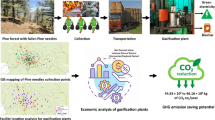Abstract
This study aims to quantify the contribution of the harvested wood products (HWP) to the carbon removals/emissions by the agriculture, forestry and land-use sector (hereafter referred to as HWP contribution) using the tier 1 method proposed by the Intergovernmental Panel on Climate Change (IPCC) in the 2006 Guidelines (hereafter referred to as GL tier 1 method) and to compare it with the results obtained with the tier 2 method proposed by the IPCC in the Good Practice Guidance for Land Use, Land-Use Change and Forestry (hereafter referred to as GPG tier 2 method). The HWP contribution was calculated for three approaches: stock change, production and atmospheric flow. Another objective was to perform a sensitivity analysis in order to identify the calculation procedures and the input data that have the largest impact on the HWP contribution estimates. An uncertainty analysis was also carried out with Monte Carlo simulation. The case study of Portugal was analysed in this study. The HWP contribution obtained with the GL tier 1 method ranged from 150 to 1,240 Gg C year−1, for the period from 1990 to 2004. These results are similar to those obtained with the GPG tier 2 method, except for the production approach, since the GL tier 1 method underestimated carbon accumulation in solid waste disposal sites (SWDS) under this approach. The most influential calculation procedures and input data were the algorithm used to calculate the change in carbon stocks for the pools that follow a first-order decay, the procedure to estimate the input of carbon to the pool of HWP in SWDS, the procedure to determine the change in carbon stocks of HWP in SWDS for the production approach, the type of carbon stocks considered in SWDS and the conversion factor for wood-based panels.



Similar content being viewed by others
References
Brown S, Lim B, Schlamadinger B (1999) Evaluating approaches for estimating net emissions of carbon dioxide from forest harvesting and wood products. Meeting report, Dakar, 5–7 May 1998. IPCC/OECD/IEA Programme on National Greenhouse Gas Inventories, Paris
Dias AC, Louro M, Arroja L, Capela I (2005) The contribution of wood products to carbon sequestration in Portugal. An For Sci 62:903–909. doi:10.1051/forest:2005081
Dias AC, Louro M, Arroja L, Capela I (2007) Carbon estimation in harvested wood products using a country-specific method: Portugal as a case study. Environ Sci Policy 10:250–259. doi:10.1016/j.envsci.2007.01.002
Dias AC, Louro M, Arroja L, Capela I (2009) Comparison of methods for estimating carbon in harvested wood products. Biomass Bioenergy 33:213–222. doi:10.1016/j.biombioe.2008.07.004
FAO (2009) FAOSTAT forestry data. http://www.faostat.fao.org
Flugsrud K, Hoem B, Kvingedal E, Rypdal K (2001) Estimating the net emission of CO2 from harvested wood products—a comparison between different approaches. Report 1831/2001. Norwegian Pollution Control Authority, Oslo
Ford-Robertson J (2003) Implications of harvested wood products accounting—analysis of issues raised by parties to the UNFCCC and development of a simple decay approach. MAF Technical Paper No 2003/5. Ministry of Agriculture and Forestry, Wellington
Hashimoto S, Nose M, Obara T, Moriguchi Y (2002) Wood products: potential carbon sequestration and impact on net carbon emissions of industrialized countries. Environ Sci Policy 5:183–193. doi:10.1016/S1462-9011(01)00045-4
IPCC (2000) Good practice guidance and uncertainty management in national greenhouse gas inventories. Intergovernmental Panel on Climate Change, Hayama
IPCC (2003) Good practice guidance for land use, land-use change and forestry. Intergovernmental Panel on Climate Change, Hayama
IPCC (2006) 2006 IPCC guidelines for national greenhouse gas inventories. Intergovernmental Panel on Climate Change, Hayama
Kohlmaier G, Kohlmaier L, Fries E, Jaeschke W (2007) Application of the stock change and the production approach to harvested wood products in the EU-15 countries: a comparative analysis. Eur J For Res 126:209–223. doi:10.1007/s10342-006-0130-x
Kohlmaier G, Kohlmaier L, Fries E, Jaeschke W (2008) Carbon stocks and greenhouse gas balance of harvested wood products: focus on the Asia-Pacific Partnership countries vis-à-vis the European Union. Eur J For Res 127:133–147. doi:10.1007/s10342-007-0190-6
Palisade Corporation (2004) @Risk—advanced risk analysis for spreadsheets, version 4.5. Palisade Corporation, Newfield
Pereira TC, Seabra T, Maciel H, Torres P (2009) Portuguese national inventory report on greenhouse gases 1990–2007 submitted under the UNFCCC and the Kyoto protocol. Agência Portuguesa do Ambiente, Amadora
Pingoud K, Wagner F (2006) Methane emissions from landfills and carbon dynamics of harvested wood products: the first-order decay revisited. Mitig Adapt Strateg Glob Change 11:961–978. doi:10.1007/s11027-006-9029-6
Pingoud K, Perälä A-L, Soimakallio S, Pussinen A (2003) Greenhouse gas impacts of harvested wood products. Evaluation and development of methods. VTT research notes 2189. VTT Technical Research Centre of Finland, Espoo
Pingoud K, Schlamadinger B, Grönkvist S, Brown S, Cowie A, Marland G (2004) Approaches for inclusion of harvested wood products in future GHG inventories under the UNFCCC, and their consistency with the overall UNFCCC inventory reporting framework. In: IEA bioenergy—task 38: greenhouse gas balances of biomass and bioenergy systems. http://www.joanneum.ac.at/iea-bioenergy-task38/hwp_september_2004.pdf
Skog KE, Pingoud K, Smith JE (2004) A method countries can use to estimate changes in carbon stored in harvested wood products and the uncertainty of such estimates. Environ Manage 33:S65–S73. doi:10.1007/s00267-003-9118-1
Winjum JK, Brown S, Schlamadinger B (1998) Forest harvests and wood products: sources and sinks of atmospheric carbon dioxide. For Sci 44:272–284
Acknowledgments
Thanks are due to FCT (Science and Technology Foundation—Portugal) for the scholarship granted to Ana Cláudia Dias (SFRH/BPD/1084/2000).
Author information
Authors and Affiliations
Corresponding author
Additional information
Communicated by K. Rosén.
This article originates from the context of the EFORWOOD final conference, 23–24 September 2009, Uppsala, Sweden. EFORWOOD—Sustainability Impact Assessment of Forestry-wood Chains. The project was supported by the European Commission.
Rights and permissions
About this article
Cite this article
Dias, A.C., Arroja, L. & Capela, I. Carbon storage in harvested wood products: implications of different methodological procedures and input data—a case study for Portugal. Eur J Forest Res 131, 109–117 (2012). https://doi.org/10.1007/s10342-011-0515-3
Received:
Revised:
Accepted:
Published:
Issue Date:
DOI: https://doi.org/10.1007/s10342-011-0515-3




